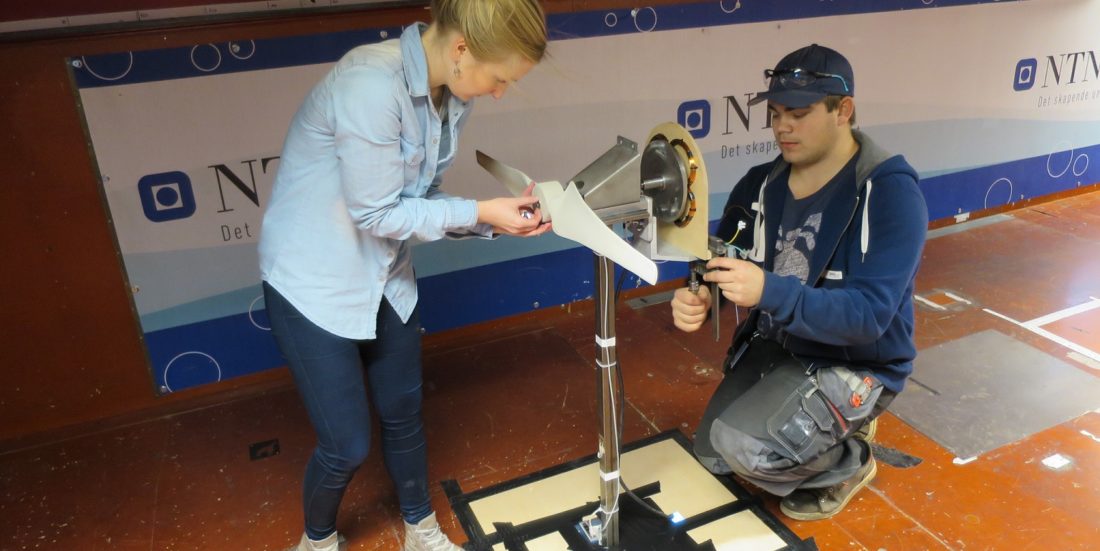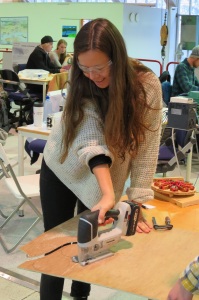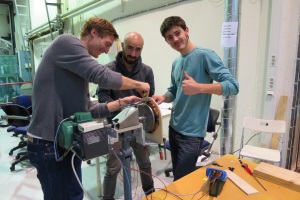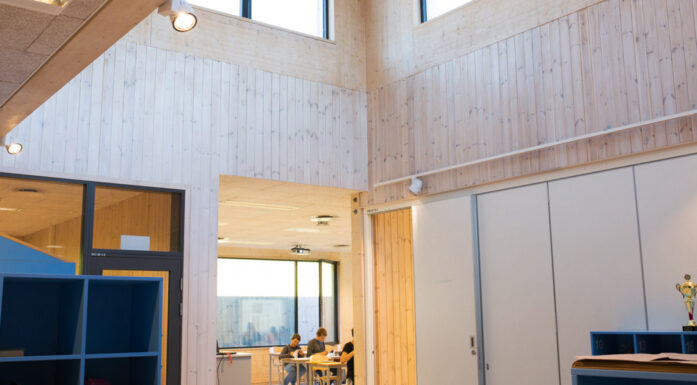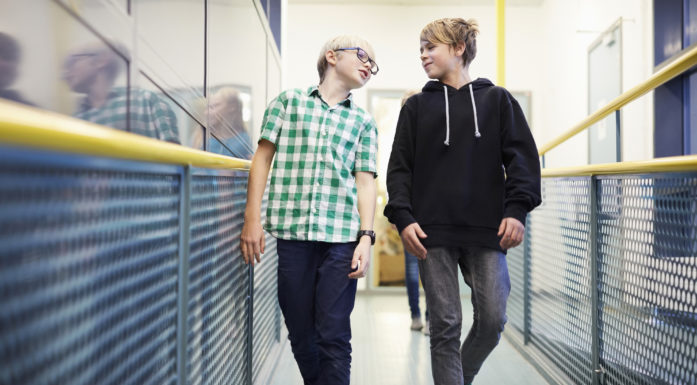Wind turbine builders put theory into practice
Engineering students at the Norwegian University of Science and Technology (NTNU) are learning about more than just theory. A competition to build the best wind turbine also gives them the chance to put their practical skills to the test.
The NTNU course “Energy from Wind and Tidal Currents” has long been popular among university students. Many are excited that they finally get to put theory into practice.
This semester’s students from NTNU competed to create the most energy efficient windmill from scratch. Adding to the challenge were students from The Technical University of Berlin (TU Berlin) who were invited to participate in the competition.
From the classroom to the workshop
“Come on,” says engineer Lars Konrad Sørensen, “take a picture now!” “It’s the first time they’re using a jigsaw,” he smiles.
“And it’s high time,” adds Sørensen, who spends time in a workshop every day.
The course “Energy from Wind and Tidal Currents” revolves around students building their own wind turbines, which are then tested in the NTNU wind tunnel. Students who took the course this fall weren’t the first budding engineers trying out tools for the first time.
During the competition around 50 students fill the mezzanine in the Thermal Engineering Laboratory. They are all working in small groups, either at a computer, discussing a model, or over a table as they assemble components.
Students go from theory to practice in the course of one semester. It is recommended that they have an understanding of basic fluid mechanics, i.e. the science of motion in fluids (gases or liquids), and how they affect other fluids or solids.
Spearheading the course are Professors Lars Roar Sætran and Ole Gunnar Dahlhaug in the Department of Energy and Process Engineering. For several semesters students have had the option to create either a wind turbine or a tidal turbine. For practical reasons, this year only wind turbines are being built, but that will change again next year.
Stimulating researcher interest
“We started this course in 2001 with only a handful of students. Today between 100 and 120 students take this course each semester,” says Dahlhaug. He notes that interest in the subject has increased in line with the number of applicants to the NTNU MSc Programme in Energy and Environmental Engineering.
“We see this competition as a step towards becoming a researcher. When students look at the test results and rankings of their wind turbines at the end of the semester, they ask themselves, ‘How can we improve the wind turbine? Why is that one less efficient?’ Then they begin to think like scientists,” he says.
Application and creativity
“This project lets us apply what we’ve learned from previous courses and see real-life results,” says student Nicole Behrens.
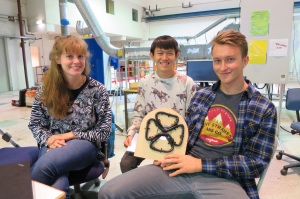
Team members Nicole Behrens, Lam Bo Jun and Vegard Moritsgård Flatjord hold up their generator, which has the characteristic clover leaf shape of copper wire. The generator is finished and will eventually be mounted on the opposite side of the turbine blades. Picture taken in Thermal Engineering Laboratory. Photo: Maren Agdestein, NTNU
Students are divided into teams of about five people each, and most teams choose to break into two groups. One group focuses on the turbine blades, while the other group works on the generator. We talk with Vegard Moritsgård Flatjord, Lam Bo Jun and Nicole Behrens, who are part of a five-person team that has opted to work as a single group throughout.
Their team has finished building the generator and they are eager to test their turbine blade.
“It’s interesting to build our own turbine,” says Vegard. “It’s more practical, and there’s no final exam,” he says, pointing out that 50 per cent of the grade consists of the poster presentation and 50 per cent is based on the report. The combined grade is then compared with the other teams.
“This course encourages you to be creative,” Nicole says.
Students explain that they started by making calculations using the mathematics program MATLAB, and then by testing these values in another program, they found the measurements they needed for the generator. Vegard, Lam Bo and Nicole don’t hesitate for a second when we ask them what they think about the competition. “We think we’ll win!”
They say that they are the first to finish their generator, and point to the other working groups around them. “We’re in the lead, and the test of our generator was also very promising.”
Students run most of the tests themselves, but some things need to be handled by professionals. For example, the very strong magnets glued to the foot of the generator are so powerful that skin can get pinched. And electronic equipment shouldn’t get too close to these magnets, either.
From a piece of wood to a wind turbine blade
Apprentice Henning Olav Harsvik sits in the basement of the Fluid Dynamics Laboratory and watches the milling machine cut out the turbine blades for the student teams.
“What is a milling machine, you ask? Well, it creates the physical turbine blades that the students have generated a computer model for,” Harsvik says.
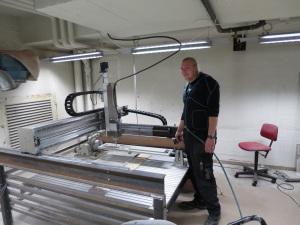
The mill is located in the basement of Fluid Dynamics Laboratory in a screened room because of the noise and dust created during milling. Henning Olav Harsvik, an apprentice, watches to make sure that everything goes smoothly. Photo: Maren Agdestein, NTNU
The mill runs at 12,000 rpm, and is somewhat similar to a 3D printer as it “saws” through the synthetic wood plank until the planned turbine blade emerges.
Students are free to design the geometry of the blade using the modeling software. Then they send their file to Harsvik, who adjusts the cutter for the given constraints, which are reflected in the milled blades.
What the students then have in hand are their blades and a hub within a support structure that keeps the blades intact during the milling process. From here, it is up to the students to sand and fine tune their blades.
“The fastest we’ve managed to crank out a turbine blade is an hour-and-a-half, but often it takes a little longer,” says Harsvik.
The excitement grows in the NTNU wind tunnel as the technical staff set up the wind turbines. Then the large doors close, and the wind starts rushing through the biggest wind tunnel in Norway. It has a maximum speed of around 100 km per hour, but today that much speed isn’t necessary.
The big screen shows the test results of the students’ wind turbines. What was the maximum wind speed the turbines were able to withstand? What was the outcome?
Efficiency is a key concept, since it’s all about how much of the wind energy can be harnessed and converted to electrical energy. The team that is next in line comments on the results of the group before them: “Look, they have 40 per cent efficiency, we should be able to reach that, too!”
Who won?
In this year’s end-of-semester competition, a student group from TU Berlin. was specially invited for the first time.
Dahlhaug and Sætran invited the German students partly to sharpen the competition. The other motive is to make it more tempting for Norwegian master’s students to go on exchange to TU Berlin. Several German master’s students have already come to study at NTNU.
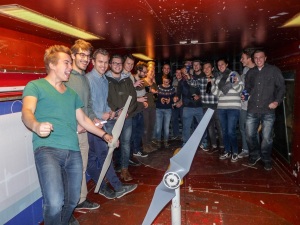
Suksess! Tre seirende grupper i vindtunnelen på en gang, med NTNU-kopper i premie.
Foto: Jan Bartl, NTNU
Competition engages not only the students, but the professors as well. Prizes are awarded for best turbine, best generator and best combination of turbine and generator.
The German students brought a turbine they had made in Berlin, using a slightly different material than that of the NTNU students. At the end of the second day, it was time for the final round of testing. A little extra tension filled the room when special adjustments on the Berlin-produced generator needed to be made to secure their turbine in the wind tunnel.
And this time around the wind turbine from TU Berlin in fact did not win the prize for best turbine/generator combination. But when all three winning student teams gathered for a victory photo in the wind tunnel, only smiles were to be seen. Perhaps one day some of these students will conduct research to improve full-scale wind turbines.
